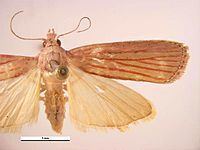Order Butterflies and moths | Rank Species | |
 | ||
Similar Tirathaba mundella, Bursaphelenchus cocophilus, Butterflies and moths, Attalea maripa, Rhynchophorus palmarum | ||
Tirathaba rufivena, the coconut spike moth, greater coconut spike moth or oil palm bunch moth, is a moth of the family Pyralidae. It is found from south-east Asia to the pacific islands, including Malaysia, the Cook Islands, the Philippines and the tropical region of Queensland. They are considered as a minor pest.
Contents
Description
Wingspan is about 26-30mm. Adults have dull green or brown forewings with thin red stripes running from the margin to the base. More or less developed annuli at middle and end of cell connected by a white streak, sometimes with a spot in base of cell also joined by the white streak. The inner margin, vein 1, the interno-median interspace and veins beyond lower angle of cell streaked with crimson. A dark marginal line. The hindwings are plain pale yellow or orange yellow.
Ecology and Attack
The larvae is the agricultural pest that feed on Cocos nucifera, Nypa fruticans, Elaeis guineensis, Musa species, and Phaseolus species. Usually caterpillar attacked male flowers where infestation causes abortion of young, results underdeveloped fruits. Severe attack can wilt the plant and delay plant development. They are not borers, only show external feeding.
Control
Biological control is the most effective method of controlling both larval and egg stages. Many different strains of parasites and pathogens are used, such as entomoparasitic nematode, Steinernema feltiae. The pathogens such as B. bassiana, and Metarhizium anisopliae are also used in many regions. Agrophylax basifulva, a tachinid fly is a known parasitoid used in Fiji. An ichneumonid Venturia palmaris are experimented in Malaysia, where they attack larva in November and December months.
Other than that, hand picking and other traditional methods are used in many countries.
